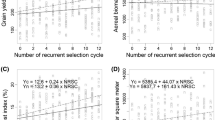Summary
Phenotypic and genotypic correlations were examined for four traits in seven populations of maize (Zea mays L.) undergoing recurrent selection. Correlations among grain yield and percentage of grain moisture, root lodging, and stalk lodging were low (|r|<0.3) except for the correlation between grain yield and stalk lodging, which was high and negative. The phenotypic and genotypic correlations agreed well from cycle to cycle within populations. Variation of correlations among populations was not significantly larger than variation among cycles. Heritabilities of these traits generally were high (h2>0.5). Two indices, one that used heritabilities as index weights and one that used relative economic weights (base index) as index weights, were compared with the Smith-Hazel index (optimim index). Relative efficiencies of the two indices, in terms of predicted gains for the individual traits and the composite trait, compared with the Smith-Hazel index, were high. The use of an index in which heritabilities were used as index weights was recommended because:1) the heritabilities were the same as the optimum weights when the traits were uncorrelated, and for the data examined the correlations were low; and 2) heritabilities were computed in routine data analyses and were available at no additional cost.
Similar content being viewed by others
References
Crosbie, T. M., J. J. Mock & O. S. Smith, 1980. Comparison of gains predicted by several selection methods for cold tolerance traits of two maize populations. Crop Sci. 20: 649–654.
Elston, R. C., 1963. A weight-free index for the purpose of ranking or selection with respect to several traits at a time. Biometrics 19: 85–97.
Hazel, L. N., 1943. The genetic basis for constructing selection indexes. Genetics 28: 476–490.
Heidhues, T., 1961. Relative accuracy of selection indices based on estimated genotypic and phenotypic parameters. Biometrics 17: 502–503.
Mulamba, N. N. & J. J. Mock, 1978. Improvement of yield potential of the Eto Blanco maize (Zea mays L.) population by breeding for plant traits. Egypt. J. Genet. Cytol. 7: 40–51.
Pesek, J. & R. J. Baker, 1969. Desired improvement in relation to selection indices. Can. J. Plant Sci. 49: 803–804.
Smith, H. F., 1936. A discriminant function for plant selection. Ann. Eugen. 7: 240–250.
Sprague, G. F. & S. A. Eberhart, 1977. Corn breeding. p. 305–362. In: G. F. Sprague (Ed.), Corn and corn improvement. Am. Soc. Agron., Madison, WI.
Subandi, W. A. Compton & L. T. Empig. 1973. Comparison of the efficiencies of selection indices for three traits in two variety crosses of corn. Crop Sci. 13: 184–186.
Williams, J. S., 1962. The evaluation of a selection index. Biometrics 18: 375–393.
Author information
Authors and Affiliations
Additional information
Joint contribution: USDA-SEA-AR and Journal Paper No. 10152 of the Iowa Agriculture and Home Economics Exp. Stn., Ames, Iowa. Project 2194.
Rights and permissions
About this article
Cite this article
Smith, O.S., Hallauer, A.R. & Russell, W.A. Use of index selection in recurrent selection programs in maize. Euphytica 30, 611–618 (1981). https://doi.org/10.1007/BF00038788
Received:
Issue Date:
DOI: https://doi.org/10.1007/BF00038788




